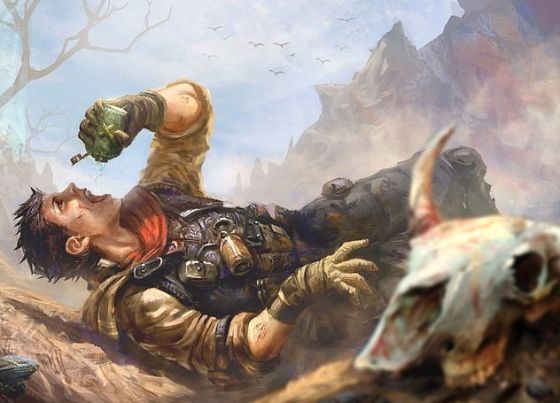Difference between revisions of "Dehydration"
Tao alexis (talk | contribs) |
Tao alexis (talk | contribs) |
||
| Line 27: | Line 27: | ||
== Water Loss & Health == | == Water Loss & Health == | ||
| + | Typically, the body loses water through respiration, perspiration, urination, defecation and general diffusion through the skin. This combined loss determines the amount of water characters must consume each day. However, there are other factors that can increase water loss: the most concerning are increased perspiration due to [[Disease|disease]], diarrhea and vomiting. In each of these cases, the individual must drink more water to compensate for the additional loss. | ||
| + | |||
| + | For game purposes, we may describe any one of these as a 20% increase in the amount of fluid that needs to be drunk that day. While not always true, rather than attempting to specify which diseases produce this requirement and which do not, it's best if we assume that the contraction of any disease increases the body's demands for fluid, regardless of severity, with any additional increase being specified within the description of the disease itself. | ||
| + | |||
| + | Diarrhea and vomiting also may occur with the onset of a disease, and should be treated as a separate +20% water intake when they do. Both may also occur as a [[Nutrition & the Preparation of Food#Quantifiable Effect of Eating|quantifiable effect of eating]], from poorly prepared grub, chow, nosh or even occasionally savoury foods. | ||
Revision as of 19:32, 24 June 2024
Dehydration is the consequence of not drinking enough water, which must be replenished every day, particularly in hot, dry weather. The amount of water that must be drunk to remain healthy is determined by the character's weight, adjusted by the day's peak temperature grade. This water need not be pure, though even mildly impure water may have unpleasant results.
In most northerly climates, dehydration is a comparatively minor concern; temperate and sub-arctic environments abound in fresh water, while humanoids need comparatively little water to maintain themselves. In hot climates, however, the lack of a fresh supply of water can quickly become dire, leading to shocking effects on the body and an unpleasant death.
| temperature grade | fl.oz./lb. of weight, per day |
|---|---|
| pleasant and below | 0.5 |
| warm, balmy or sweaty | 0.6 |
| sweltering to feverish | 0.7 |
| baking | 0.9 |
| scorching | 1.2 |
For those unfamiliar with fluid ounces, there are 16 fl.oz. in a pint, 32 fl.oz. in a quart, 128 fl.oz. in a gallon and 33.8 fl.oz. in a litre.
Water Requirements
The table indicates the amount of water that a character needs, depending upon his or her weight and the relative temperature. A 100-lb. character, for example, in pleasant conditions (up to 69°F/21°C), would need to drink about 50 fluid ounces of water to remain hydrated, which is a little more than 1½ quarts. In warm, balmy, or sweaty conditions (between 70-99°F/22-37°C), that same character would need to drink 60 fluid ounces each day, nearly two quarts.
A goatskin bag or a winesack, used to carry fluid, each has a capacity of two quarts, showing that characters must find a source of water nearly every day when travelling. Common sources of water that even outsiders may access include natural springs, rivers, streams and wells, as well as rainwater collected in cisterns or barrels. Thus, every thorp or hamlet becomes an important place for characters to stop at.
It's beneficial if a party carries along a keg, which has a capacity of five gallons, for extended travel to places where there might not be an immediate water source. This, of course, requires a donkey or other pack animal, as a full keg weighs more than 33 lbs. Additionally, it's advisable to have other portable containers that can be easily carried and refilled, ensuring a constant supply of water for hydration needs.
Water Loss & Health
Typically, the body loses water through respiration, perspiration, urination, defecation and general diffusion through the skin. This combined loss determines the amount of water characters must consume each day. However, there are other factors that can increase water loss: the most concerning are increased perspiration due to disease, diarrhea and vomiting. In each of these cases, the individual must drink more water to compensate for the additional loss.
For game purposes, we may describe any one of these as a 20% increase in the amount of fluid that needs to be drunk that day. While not always true, rather than attempting to specify which diseases produce this requirement and which do not, it's best if we assume that the contraction of any disease increases the body's demands for fluid, regardless of severity, with any additional increase being specified within the description of the disease itself.
Diarrhea and vomiting also may occur with the onset of a disease, and should be treated as a separate +20% water intake when they do. Both may also occur as a quantifiable effect of eating, from poorly prepared grub, chow, nosh or even occasionally savoury foods.
